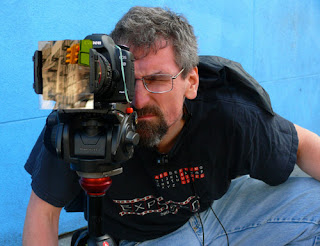… or, some details on what went right and what went wrong during production. This will necessarily be a short blog entry; in the future I’ll go into more details on some of these points.
What Went Right
The Small Crew Size: I’ve worked with crews of 30 people, each of whom were getting paid very little money, and consequently tended to be less experienced. This necessitated adding more shooting days to the schedule. I decided to go the opposite route, hire more experienced people, pay them a little better, and have a smaller group overall and fewer shooting days. It should be noted that I did hire a number of interns, all whom did excellent work. But because we had experienced keys, I didn’t need the same level of infrastructure to manage them.
The Five Day Week: I think that shooting a sixth day is basically a waste of time, unless it’s absolutely necessary. Since most people are getting paid a day rate, and you’re probably not paying full retail for gear and locations anyway, why put yourself through a sixth day of shooting when you can use that time to organize the following week, or maybe, I don’t know, get some sleep?
Starting With the Hard Stuff: During our first week, we shot about 36 pages. Nearly our entire cast worked the first week. We shot a number of long scenes with some very tricky stuff going on (five people talking and moving around). We had very little control over the environment, and had some bouts of inclement weather (though it wasn’t as bad as it could have been). But by the end of the first week, we had a tightly knit cast and crew, and shot an incredible 36 pages in only five days. Also, by putting the crew through their paces, I also got a sense of how they worked and what the pattern of the day would be.
Scheduling Actresses Later: Whenever possible, we tried to schedule scenes with actresses for later in the day, so that we wouldn’t be waiting on hair/makeup and wardrobe. This put a little less pressure on Ghislaine and Janis, and let us get our first shot off a little faster.
Block Shooting Some Scenes: There were several points where we decided to shoot out an angle for all the scenes, then turn around, rather than cover a single scene at a time. This works best, obviously, when you only have a few angles you can shoot a given set of scenes from, or where there’s supposed to be a visual similarity between scenes. This saved us a lot of time relighting and repositioning.
Staying In One Place The First Week: Our first week’s work was in one location – the vendor street, which happened to be (in real life) the corner of Davidson and Burnside Ave in the Bronx. We had a wonderful holding space, the Davidson Community Center. Being able to stay in one place and get organized, while also shooting a lot of challenging material, was crucial.
Starting Prep Early: Everyone says that production is determined by preproduction, but it’s very true. We started location scouting in April and May; locking down locations, vendors, and crew in June; casting in July and August; analyzing and breaking down the script in March and April… the truth is that if you don’t have a lot of money, you HAVE to take the time to figure out the shoot before you get on set.
Switching Caterers a Lot: We switched our caterer several times during the course of the shoot, which worked well because it meant not getting bored with one cuisine or another.
WHAT WENT WRONG:
Trying to Bite Off More Than I Could Chew on the Stunt Days:
We went into overtime on both days that we had stunts, and ended up owing some footage on one of the days that we didn’t make up until the last day of the shoot. When tallied together, the OT overages (on the crew, cast, and locations), combined with the additional day that I had to hire one of the cast for, nearly equaled another day of shooting. Lesson learned!
No Key PA: This was a painful position to eliminate during the budgeting process, but I couldn’t figure out how to squeeze it in, especially as other costs started to rack up. The problem is that without someone a little more experienced to kind of run the other PAs, a good chunk of the job fell on me. That’s not a bad thing – sometimes I think directors could use to be a little more in touch with everyone in the crew – it was sometimes very distracting.
This is not to take anything away from the PAs; they worked their butts off and took a lot of initiative.
Not Enough Good Vegan Options: I should have worked out better vegan options with each of the caterers. Some delivered good options, others didn’t get it. The vegans in the cast and crew were very easy-going but they didn’t have to be. Next time I’ll get it right, guys!
That’s it for now. I will try to post one more piece before the end of the year. If I don’t, then have a great new year and a happy holiday season!

